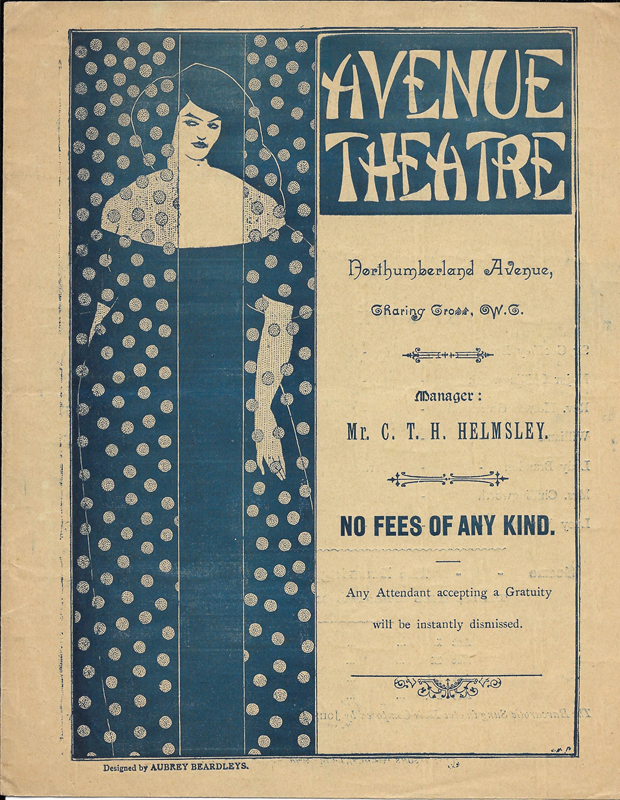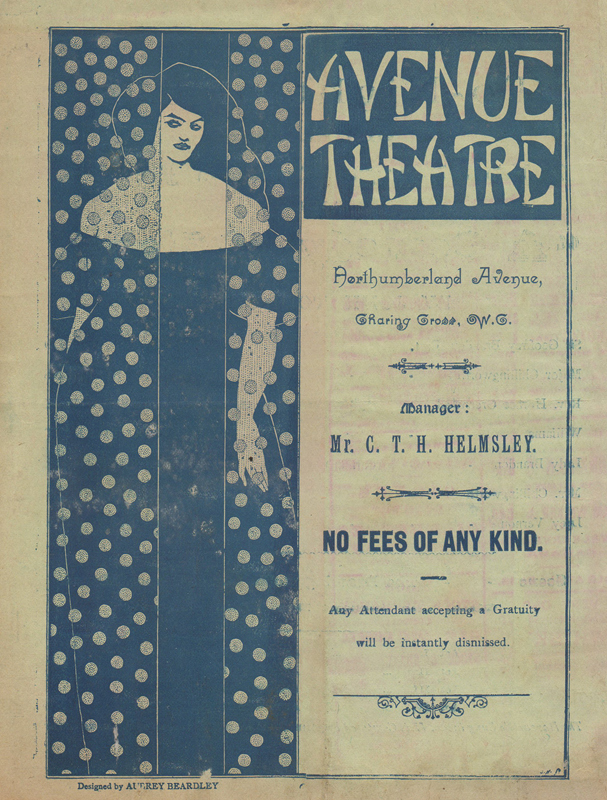Essays Current Research ReviewsContributorsAnnouncements
Home
Aubrey Beardsley and variant programmes for John Todhunter's A Comedy of Sighs
and W B Yeats' The Land of Heart's Desire
by
Michael Seeney & Steven Halliwell
This article looks at the background to the Florence Farr season at the Avenue Theatre in 1894 and the reasons for variant programmes for the first production of that season.
Early in 1894 the actress Florence Farr approached Aubrey Beardsley to design the poster and programme for her forthcoming season at the Avenue Theatre in Northumberland Avenue, London. Although there must have been more discussion, there is one extant letter from Beardsley to Farr which the editors of his letters tentatively date as “circa February 1894”. In it Beardsley says:
I think you will find dark green on light the most satisfactory scheme of colour, though it has often been used before for magazine covers etc. Of course I should make my design in black and white, so that a zinc block can be made, and from that you can print in any colour you like. By the way, if my design is going to be used as a poster had I not better draw it large size and have it reduced for programme?1
Beardsley also notes his understanding that no theatre had been settled for the production and there was therefore a delay before the illustration could be completed. It cannot have been a long delay because on 8 March Farr wrote to The Era from the Avenue Theatre:
Sir, - As my name has been mentioned in connection with the management of the new undertaking at the Avenue Theatre, may I explain that I am simply acting for someone else, who, wishing to remain unknown in the matter, has commissioned me to try the experiment of producing, under adequate artistic conditions, plays of a class outside the ordinary routine of theatrical enterprise. There are many stringent conditions imposed on me as to the manner of production, as well as the matter produced, and if the whole thing fails to attract the public, a new departure will at least have had a fair trial.
The newspapers tried to discover the identity of her backer without success and all assumed it to be a man. It was, however, Annie Horniman, a member with W B Yeats and Farr of the Order of the Golden Dawn. Yeats and Todhunter lived in the aesthetic London suburb of Bedford Park, with Yeats being the neighbour of Farr’s sister. Horniman had provided the money and clearly had a strong view of the sort of play to be produced and the manner of its production. As one paper complained before the season opened, “he not only determines the kind of play to be produced, but refuses to allow the management to engage a band. Why the mystery man should object to an orchestra I cannot divine”.2
In an interview in the Pall Mall Gazette, published on the day the season opened, Farr explained this decision:
Between the acts people will be able to talk. Better that, we think, than to have their attention interrupted by the indifferent performance of an utterly irrelevant waltz.
The curtain raiser on the first night was Yeats’s The Land of Heart’s Desire. The critics found it “weird and depressing” but “some of the lines are happily expressed”, although the Western Mail thought it “amateurish” and that while Yeats “may be a very gifted author” he was “ignorant of the very first principles of playwriting”. Many of Yeats’s lines could not be heard, partly because the actors were not projecting well enough and partly because the audience was already making a considerable noise, which got worse when Todhunter’s A Comedy of Sighs began.
A Comedy of Sighs drew harsher criticism, most particularly because a female character swears; as the Western Mail said:
Possibly there are women who so degrade themselves and their sex as to insist that “Women are such d-----d fools,” or an emancipated woman to assert “I’ve made a d-----d fool of myself,” and to playfully declare that “I have been playing hell and tommy,” but even the staunchest upholders of the “notable theatrical experiment” thought that the line must be drawn at a cursing woman, and they retorted by giving her the medicine that she had prescribed for herself.3
The audience reaction was to hiss and the Western Mail again echoed the sentiments of other critics by saying that
It is as well to break the force of folly before it goes further. The lesson was needed, and it was given in grim earnest. There is much virtue in an honest hiss. It clears the theatrical atmosphere of pretentiousness, pachydermatous indifference to the feelings of the community at large, and deplorable conceit.
Reynolds’s Newspaper criticised the play but conceded that the writing was not all that was at fault:
But the best dramatic work would have stood a slender chance with the companies who bored and irritated the public on Thursday night at the Avenue.4
The overall reaction was such that Farr and the theatre manager, C T H Helmsley needed to take urgent action. Although Farr had already played in Todhunter’s Sicilian Idyll, he wasn’t her (or Horniman’s) first choice for the Avenue Theatre season. She had negotiated with George Bernard Shaw (with whom she was conducting an affair) for his play Arms and the Man, but Shaw had not thought it ready for the stage. On the first night of A Comedy of Sighs, Shaw received a telegram summoning him to the Avenue immediately. When he got there Farr and Hemsley were contemplating – “in despair” – producing Widowers’ Houses. According to Shaw
I dissuaded them from that and after some discussion took my new play [Arms and the Man] out on to the Embankment Gardens and there and then put the last touches to it before leaving it to be typewritten.5
That was on 29 March; by 11 April it was in rehearsal.
As soon as it became apparent, Farr and Hemsley did their best to counter the opposition to their experiment by reinstating the orchestra. The experiment lasted only three nights, after which Wurm’s Viennese White Band was hired to “wile away the entr’actes”. As the Glasgow Herald said, “curiously enough it proved that music was absolutely required to set the conversation going”. The Viennese White Band was named after the white uniforms they wore in imitation of Austrian military uniforms; Gustav Holst played trombone in Wurms’s band before his compositions gave him a suitable income but whether he played at the Avenue is not known.
Two days after rehearsals started, Arms and the Man was advertised as opening on 21 April; the theatre would be closed from 16 to 20 April “for final rehearsals”.
In all, when the final curtain fell on A Comedy of Sighs on 14 April it had been performed sixteen times, including a matinee on 7 April. The curtain raiser, The Land of Heart’s Desire continued to play with Arms and the Man until 12 May, after which Louis N Parker’s The Man in the Street took its place and continued for the rest of the run. Shaw’s play was performed seventy six times but still managed to make a loss of £4000.6
Although Farr had financial support from Annie Horniman, the operation was still run on a shoe string and this may have affected the production of programmes and posters. In the letter quoted at the beginning of this piece, Beardsley suggested that a zinc block be made; in the end both poster and programme were printed lithographically. It was unusual, perhaps unprecedented, to use the same image for poster and programme, and for both the same blue was used, although the poster added green for the flowers on the curtain and for the titles of the plays. When Arms and the Man was produced, the programme was printed in black and white with a red border. No copy of the poster for Arms and the Man has been examined.
It is believed that, for the total of sixteen performances of A Comedy of Sighs, four variant programmes were produced.
The earliest programme examined, [Fig. 1] which was almost certainly the first night programme is of four pages and has as the headline on the inside page
Thursday, March 29th, 1894
And EVERY EVENING at 8.40,
WILL BE ACTED
A New and Original Comedy, in Four Acts
Beneath the image on the front it says
Designed by AUBREY BEARDLEYS
The second programme [Fig. 2] is from later in the run because it credits Wurm’s Viennese White Band. It must, therefore be from the fourth performance or later. The headline on the inside page is:
To-Night at 8.40,
WILL BE ACTED
A New and Original Comedy, in Four Acts
Beneath the image on the front it says
Designed by AUBREY BEARDLEY
A third programme, for a date unknown, but also with Beardsley’s name misspelled is included in the catalogue of the Aubrey Beardsley exhibition at the Victoria and Albert Museum in 1966 (item 368).7 The catalogue states that beneath the image on the front the name is given as
AUBREY BEARDSLEYS
A fourth programme, the front of which is reproduced in Aubrey Beardsley by Matthew Sturgis (p.185),8 shows the correct spelling of Beardsley’s name.
Programmes for Arms and the Man have the correct spelling.
Only the first two programmes described above have been examined, and we would welcome details of the whereabouts of further copies, particularly of the latter two variants.
Notes

